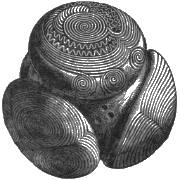Canmore Site 60612: NORTH PORT O'SPITTAL - STONEYKIRK - INHUMATION (BRONZE AGE), SHORT CIST (BRONZE AGE), CINERARY URN (POTTERY)(BRONZE AGE), FOOD VESSEL (POTTERY)(BRONZE AGE)
Description
| Site Name | NORTH PORT O'SPITTAL |
|---|---|
| Other Name(s) | n/a |
| Site Number | NX05SW 11 |
| Broad Class | RELIGIOUS RITUAL AND FUNERARY, CONTAINER, RELIGION OR RITUAL |
| Site Type(s) | INHUMATION (BRONZE AGE), SHORT CIST (BRONZE AGE), CINERARY URN (POTTERY)(BRONZE AGE), FOOD VESSEL (POTTERY)(BRONZE AGE) |
| NGR | NX 0277 5240 |
| NGR accuracy | NGR given to the nearest 10m |
| Local Authority | DUMFRIES AND GALLOWAY |
| Parish | STONEYKIRK |
| Record created | 1988-07-04 |
| Last updated | 2000-04-12 |
Archaeology Notes
NX05SW 11 0277 5240.
In 1899, a short cist was found in a sand-pit on the farm of Port of Spittal on the sloping south-east side of the field in which there is a standing stone (NX05SW 2), and in which many grave-slabs were turned up many years ago. It measured 3'9" in length with a breadth and depth of 2'6" and was covered by a large whinstone slab. It contained a food vessel, irretrievably smashed, a jawbone containing nine teeth and other small pieces of bone.
Locally the field is known as "The burial ground of the four Kings." (see also ONB entry attached to NX05SW 2).
F R Coles 1900; L M Mann 1915; D D A Simpson 1965; Galloway Gazette 5 November 1899
From ground inspection it would appear that the sand-pit is the "gravel-pit" published on OS 25" plan at NX 0277 5240. The pit, no longer used, is partially grassed over, and lying near its centre is a flat slab 1.0m long x 0.6m wide x 0.1m thick.
In Stranraer Museum, from the field known as the 'burial ground of the four Kings' are the following finds - Nine teeth, five fragments of long bone with urn fragments and three fragments of coarse pottery, from a BA burial in 1899. Donor, Miss Robertson, Mardale Crescent, Edinburgh. (Acc. Nos: 1954/3+4).
Visited by OS (WDJ) 1 September 1970
About 29 October 1899 a cist was discovered in a sand pit about 70m ESE of the standing stone at North Port O'Spittal. The coverstone, a large whinstone slab, lay about 0.9m below the surface of the field, and the cist, which was aligned from E to W, measured about 1.15m by 0.75m and 0.75m in depth; it contained the remains of an inhumation and, in the SE corner, a broken 'urn'. Fragments of the urn, three sherds of coarse pottery, nine teeth and five pieces of long bone are preserved in the Stranraer Museum (1954/3 and 4).
The Antiquary 1899; F R Coles 1900; RCAHMS 1985
Identifiers and Links to Other Records
This record has no links! Would you like to help?
| Identifier / External Link | Linked Record | Status | Comment |
|---|---|---|---|
| Canmore Site Number (legacy): NX05SW 11 | No linked record |
This area is visible only to logged in users.
